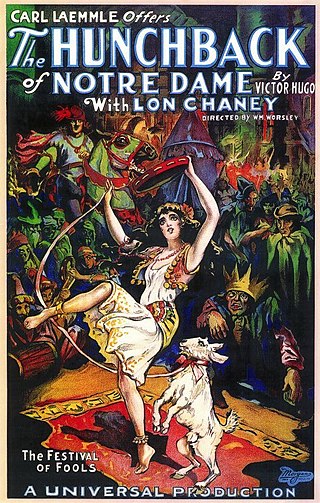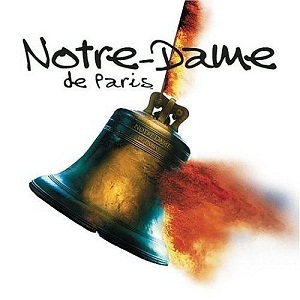
The Hunchback of Notre-Dame is a French Gothic novel by Victor Hugo, published in 1831. The title refers to the Notre-Dame Cathedral, which features prominently throughout the novel. It focuses on the unfortunate story of Quasimodo, the Roma street dancer Esmeralda and Quasimodo's guardian the Archdeacon Claude Frollo in 15th-century Paris. All its elements—the Renaissance setting, impossible love affairs and marginalized characters—make the work a model of the literary themes of Romanticism.

The Hunchback of Notre Dame is a 1939 American romantic drama film starring Charles Laughton and Maureen O'Hara. Directed by William Dieterle and produced by Pandro S. Berman, the film is based on Victor Hugo's 1831 novel. The film is also noted for being the first film ever shown at the Cannes Film Festival before the rest of the festival was cancelled due to the start of World War II.

Quasimodo is a fictional character and the titular character of the novel The Hunchback of Notre-Dame (1831) by Victor Hugo. Quasimodo was born with a hunchback alongside several facial deformities and feared by the townspeople as a sort of monster, but he finds sanctuary in an unlikely love that is fulfilled only in death.
Clopin Trouillefou is a fictional character first created in the 1831 novel The Hunchback of Notre-Dame by French author Victor Hugo, and subsequently adapted.

Pierre Gringore was a popular French poet and playwright.

The Hunchback of Notre Dame is a 1923 American drama film starring Lon Chaney, directed by Wallace Worsley, and produced by Carl Laemmle and Irving Thalberg. The supporting cast includes Patsy Ruth Miller, Norman Kerry, Nigel de Brulier, and Brandon Hurst. Distributed by Universal Pictures, the film was the studio's "Super Jewel" of 1923 and was their most successful silent film, grossing $3.5 million. The film premiered on September 2, 1923 at the Astor Theatre in New York, New York, then went into release on September 6.

Claude Frollo is a fictional character and the main antagonist of Victor Hugo's 1831 novel The Hunchback of Notre-Dame. He is an alchemist and intellectual, as well as a Catholic clergyman.

Arthur Goring Thomas was an English composer.

Notre-Dame de Paris was a sung-through French musical which debuted on 16 September 1998 in Paris. It is based upon the novel Notre-Dame de Paris by the French novelist Victor Hugo. The music was composed by Riccardo Cocciante and the lyrics are by Luc Plamondon.

The Hunchback of Notre Dame is a 1956 French-Italian CinemaScope film version of Victor Hugo's 1831 novel, directed by Jean Delannoy and produced by Raymond Hakim and Robert Hakim. It stars American actor Anthony Quinn and Italian actress Gina Lollobrigida. The film is the first version of the novel to be made in color.
La Esmeralda is a ballet in three acts and five scenes, inspired by the 1831 novel Notre-Dame de Paris by Victor Hugo, originally choreographed by Jules Perrot to music by Cesare Pugni, with sets by William Grieve and costumes by Mme. Copère.

Esmeralda, born Agnès, is a fictional character in Victor Hugo's 1831 novel The Hunchback of Notre-Dame. She is a French Roma girl. She constantly attracts men with her seductive dances, and is rarely seen without her clever goat Djali. She is around 16 years old and has a kind and generous heart.

CapitainePhœbus de Châteaupers is a fictional character and the secondary antagonist of Victor Hugo's 1831 novel, Notre-Dame de Paris. He is the Captain of the King Louis XI's Archers. His name comes from Phoebus, the Greek god of the sun.

The Hunchback is a 1997 made-for-television romantic drama film based on Victor Hugo's iconic 1831 novel The Hunchback of Notre-Dame, directed by Peter Medak and produced by Stephane Reichel. It stars Richard Harris as Claude Frollo, Salma Hayek as Esmeralda and Mandy Patinkin as Quasimodo, the titular hunchback of Notre Dame. The film premiered on March 16, 1997 on TNT.
The Hunchback of Notre Dame is a British feature length adaptation of the 1831 novel by Victor Hugo, produced for television by the BBC in 1976 and aired on December 30 the same year. Directed by Alan Cooke and written by Robert Muller, the film stars Kenneth Haigh as Claude Frollo, Warren Clarke as Quasimodo and Michelle Newell as Esmeralda, and features the visual effects by Ian Scoones and the original music by Wilfred Josephs.
The Hunchback of Notre Dame is a 1986 Australian/American fantasy animated film and an adaptation of the 1831 novel The Hunchback of Notre-Dame by Victor Hugo.
The Hunchback of Notre Dame is a 1966 British television series, an adaptation of the 1831 novel by Victor Hugo, directed by James Cellan Jones. It starred Peter Woodthorpe as Quasimodo and Gay Hamilton as Esmeralda. The screenplay was by Vincent Tilsley. Although some photographs exist, no recordings of the production are known to have survived.

La Esmeralda is a grand opera in four acts composed by Louise Bertin. The libretto was written by Victor Hugo, who had adapted it from his 1831 novel Notre-Dame de Paris. The opera premiered at the Théâtre de l'Académie Royale de Musique in Paris on 14 November 1836 with Cornélie Falcon in the title role. Despite the lavish production, the premiere was a failure, and La Esmeralda proved to be the last opera composed by Bertin, although she lived for another 40 years.
Miss Esmeralda is a Victorian burlesque, in two acts, with music by Meyer Lutz and Robert Martin and a libretto by Fred Leslie, under his pseudonym "A. C. Torr", and Horace Mills. It is based on Victor Hugo's 1831 novel The Hunchback of Notre-Dame.

Esmeralda is an 1856 grand opera in four acts with a score by the Italian composer Vincenzo Battista. With a libretto in English by Charles Jefferys, it was based on Battista's Italian version Ermelinda (1851), which in turn was based on Hugo's 1831 novel The Hunchback of Notre-Dame.

















